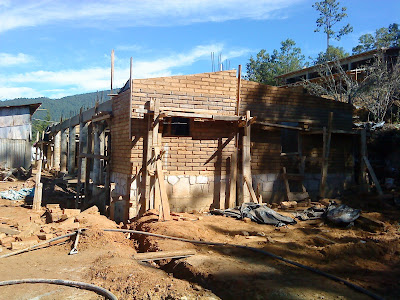This project is fruit of a movement of traditional medicine practitioners which mark the beginning of their organization and the trajectory of this project with meetings and conferences at local, regional and state levels in Oaxaca sponsored by the Instituto Nacional Indigenista (National Institute of Indigenous Peoples) beginning in 1985. The eventual formation of a legal entity in 1999 named Consejo Estatal de Médicos Indígenas Tradicional de Oaxaca A.C. (Council of Indigenous Traditional Medicine Practitioners of Oaxaca ) or CEMITO provided the impetus for the construction of this center. Here are a couple of googleearth images showing the location of the state of Oaxaca inside México, and then the approximate location of the construction site of the center relative to the valley where the city of Oaxaca, capitol of the state, is located.
The center is located on the outskirts of the town of Capulalpam, a lovely Zapotec pueblo located less than two hours by car in the mountains north of the city of Oaxaca at an altitude of approximately 6,400 feet. Here you will find cabins for rent, restaurants featuring trout from the local farms, and eco-tourism activities like hiking in the surrounding forests, as well as scenery such as this to entice photographers.
The nearby site of the center was chosen by the local practitioners for its orientation, altitude and the proximity of the medicinal plants used in some treatments, as well as a nearby spring which provides the source for running water which is important in some forms of therapy. The materials for construction are primarily of local origin, such as the adobe bricks being fabricated below from local soil.
These vigas in the following photos came from the surrounding forest, cut in the local sawmill, and were shaped by the carpenter by hand using a plane, chisel and hammer. The Zapotec community have a long history of managing local resources in a sustainable manner so that future generations can also take advantage of what nature has provided them.

The materials and indeed the buildings themselves reflect the requirements of the traditional therapeutic methodologies. The temazcal bath is an important traditional treatment similar to a sauna which is here is being built in the preferred form.
The final shape of the temazcal can be seen below where the entrance is a small archway within the main building. Visible behind the dome is the chimney where the fire is built and exposed to the stones that provide the actual source of heat; water with herbs is poured on the stones to make steam for the bath.
The building in the following photo was described as the laboratory. When I asked what role a laboratory plays in traditional medicine, I was surprised and excited by the answer. When the traditional medicine involves therapy with herbs which come from the surrounding forest, they will be brought here for preparation, and in addition will be analyzed by student interns from the university in the valley to understand what the preparations contain, and hopefully increase the understanding of the efficacy of the treatments. The idea is that some of the preparations may be commercially viable to provide a financial basis for the continued work of the center, and the construction of others like it.
When I visited the site in November, the seasonal weather was starting to impact the ability to proceed with the work. The construction site is over 7000 feet elevation, and often quite literally "in the clouds".
The trip down to the valley where many of the workers live is too long to make on a daily basis, so they live on site, returning home only on the weekends. This is a photo of the improvised housing where the workmen live during the week which will one day be the vista from the front entry of the center.
.jpg)









